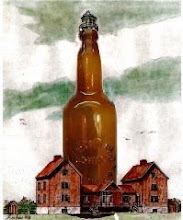beerandwinejournal. Dr. Chris White of White Labs and his staff made up a standard wort, with a known (calculated) level of bitterness, and fermented aliquots of it with each of the White Labs strains. Each beer was then analyzed for its actual level of bitterness (in IBUs). He then compared the measured IBUs to the predicted IBUs for each strain. If the two were equal, the beer was given a score of 1. If the measured IBUs were less than the predicted IBUs, the beer received a score between zero and one. For example, if the beer was expected to have 100 IBUs, but only had 80, the beer would be given a 0.8. (Note: the experiment wasn’t done with 100 IBU beers, I just used that number as an example because it’s easy to see how the proportions worked out.) And if the beer was more bitter than predicted, the beer received a number over 1.
Interestingly, over two thirds of the yeast strains received below a 1. The strains that scored among the lowest — WLP029 (German Ale/Kölsch), WLP300 (Hefeweizen Ale) and WLP 380 (Hefeweizen IV Ale) — scored around 0.5. In other words, the level of bitterness was half what the recipe calculator predicted! Other strains that scored under 1 include WLP002 (English Ale) and WLP041 (Pacific Ale) yeast. Interestingly, these were already described as leaving a malty profile.
It should come as no shock that among the strains that scored 1 or above were the strains frequently used in American-style IPAs. White Labs WLP001 (California Ale), White Labs most popular strain, scored around 1, as did WLP550 (Belgian Ale) yeast. Strains that were slightly above 1 include WLP005 (British Ale), WLP810 (San Francisco Lager), WLP830 (German Lager), WLP860 (Munich Helles), WLP039 (East Midlands Ale) and WLP862 (Cry Havoc).
It’s been known for a long time that yeast takes some of the bitterness out of worts. That’s why, for instance, Vinnie Cilurzo of Russian River recommends slightly underpitching beers that are meant to be intensely hoppy. Exactly how this occurs is not known. It may have something to do with the electrical charges on iso-alpha acid and the charges of proteins embedded in the yeast cell wall. When the yeast flocculate, they may pull iso-alpha acids with them.
Now that you know that some yeast strains may be bogarting your IBUs, what should you do? Well, if you’re following a recipe that someone else has actually brewed and liked, follow the recipe. Whatever effect the yeast has will have been counteracted by the brewer adjusting the hop amounts to get the right flavor and aroma. If you’re formulating your own recipes from scratch, be aware that you might have to adjust the amount of hops upward to get the level of bitterness you’re looking for.
It’s probably no coincidence that some of the strains that scrub the most IBUs from the wort are usually used in beer styles that aren’t very bitter. And likewise, most super-hoppy recipes use clean ale yeasts, which many of the strains rated around 1 were.
The differences among strains could be interesting when making hybrid style beers, like hoppy hefeweizens of Belgian IPAs.
White plans to release the numbers when he and his lab has tested the yeast strains all again to see if the results are repeatable. Once these numbers become available, they can simply be incorporated into recipe calculation spreadsheets and help brewers better formulate their beers.
Tuesday, February 25, 2014
Subscribe to:
Post Comments (Atom)



No comments:
Post a Comment